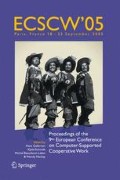Abstract
Loosely coupled workgroups — where workers are autonomous and weakly interdependent — are common in the real world. They have patterns of work and collaboration that distinguish them from other types of groups, and groupware systems that are designed to support loose coupling must address these differences. However, loosely coupled groups have not been studied in detail in CSCW, and the design process for these groups is currently underspecified. This forces designers to start from scratch each time they develop a system for loosely coupled groups, and they must approach new work settings with little information about how work practices are organized. In this paper, we present a design framework to improve the groupware design process for loosely coupled workgroups. The framework was developed to provide designers with a better understanding of how groupware systems can be designed to support loosely coupled work practices. It is based on information from CSCW and organizational research, and on real-world design experiences with one type of loosely coupled group—home care treatment teams. The framework was used to develop Mohoc, a groupware system for home care, and the system and underlying framework were evaluated during two field trials.
Access this chapter
Tax calculation will be finalised at checkout
Purchases are for personal use only
Preview
Unable to display preview. Download preview PDF.
References
Aldrich, H. (1979): Organizations and Environments, Prentice Hall, Englewood Cliffs, NJ.
Bellotti, V., Bly, S. (1996): ‘Walking away from the desktop computer: distributed collaboration and mobility in a product design team’, Proc. CSCW’96, ACM Press, pp. 209–218.
Bertrand, A.L. (1972): Social Organization: A General Systems and Role Theory Perspective, F.A. Davis, Philadelphia.
Brusoni, S., Prencipe, A. (2001): ‘Managing knowledge in loosely coupled networks: exploring the links between product and knowledge dynamics’, Journal of Management Studies, 38(7), pp. 1019–1035.
Churchill, E.F. and Wakeford, N. (2001): ‘Framing mobile collaboration and mobile technologies’, in Brown, B., Green, N., Harper, R. (eds.): Wireless World: Social and Interactional Implications of Wireless Technology, New York, Springer-Verlag.
Daft, R.L., Lengel, R.H. (1986): ‘Organizational information requirements, media richness and structural design’, Management Science, 32(5), pp. 554–571.
DiTomaso, N. (2001): ‘The loose coupling of jobs: the subcontracting of everyone?’, in Berg, I. and Kalleberg, A.L. (eds.): Sourcebook of labor markets: evolving structures and processes., Kluwer Academic/Plenum, New York, pp 247–270.
Fagrell, H., Forsberg, K., Sanneblad, J. (2000): ‘FieldWise: a mobile knowledge management architecture’, Proceedings CSCW 2000, ACM Press, pp. 211–220.
Firestone, W. (1985): ‘The study of loose coupling: problems, progress and prospects’, in Kerckhoff, A. (ed.): Research in Sociology of Education and Socialization, Greenwich, CT, JAI Press, 5:3–20.
Foster, W. (1983): Loose-coupling Revisited: A Critical View of Weick’s Contribution to Educational Administration, Victoria University Press, Victoria, Australia.
Grinter, R.E., Herbsleb, J.D., Perry, D.E. (1999): ‘The geography of coordination: dealing with distance in R&D work’, Proc. GROUP 1999, ACM Press, pp. 306–315.
Hasenfeld, Y. (1983): Human Service Organizations, Prentice Hall, Englewood Cliffs, NJ.
Horne, S. (1992): ‘Organization and change within educational systems: some implications of a loose-coupled model’, Educational Management and Administration, 20(2), pp 88–98.
Kmetz, J.L. (1984): ‘An information-processing study of a complex workflow in aircraft electronics repair’, Administrative Science Quarterly, 29(2), pp. 255–280.
Kouzes, J.M. and Mico, P.R. (1979): ‘Domain theory: an introduction to organizational behaviour in human service organisations’, Journal of Applied Behavioural Sciences, 15(4), pp. 449–469.
Lei, D., Hitt, M.A., Goldhar, J.D. (1996): ‘Advanced manufacturing technology: organizational design and strategic flexibility’, Organization Studies, 17(3), pp.501–523.
Litterer, J.A. (1965): The Analysis of Organizations, John Wiley & Sons, New York.
Lorsch, J.W. (1973): ‘An open-system theory model for organizational research’, in Negandhi, A.R. (ed.): Modern Organizational Theory: Contextual, Environmental, and Socio-cultural Variables, Kent State University Press, Kent, Ohio, pp. 132–144.
Lutz, F.W. (1982): ‘Tightening up loose coupling in organizations of higher education’, Administrative Science Quarterly, 27, pp. 653–669.
Monane, J.H. (1967): A Sociology of Human Systems, Meredith Publishing, New York.
Olson, J.S. and Teasley, S. (1996): ‘Groupware in the wild: lessons learned from a year of virtual collocation’, Proc. CSCW 1996, ACM Press, pp. 419–427.
Orton, J.D. and Weick, K.E. (1990): ‘Loosely coupled systems: a reconceptualization’, Academy of Management Review, 15(2), pp. 203–223.
Perrow, C. (1999): Normal Accidents: Living with High-risk Technologies, Princeton University Press, Princeton, NJ.
Pinelle, D. (2004): Improving Groupware Design for Loosely Coupled Groups, Ph.D. thesis, Department of Computer Science, University of Saskatchewan, Canada.
Pinelle, D. and Gutwin, C. (2003): ‘Designing for loose coupling in mobile groups’, Proceedings of GROUP 2003, ACM Press, pp. 75–84.
Rubin, I.S. (1979): ‘Retrenchment, loose structure and adaptability in the university’, Sociology of Education, 52(4), pp. 211–222.
Scheid-Cook, T.L. (1990): ‘Ritual conformity and organizational control: loose coupling or professionalization?’, The Journal of Applied Behavioral Science, 26(2), pp. 183–99.
Scott, W.R. (1987): Organizations: Rational, Natural, and Open Systems, 2nd ed., Prentice-Hall, Englewood Cliffs, NJ.
Scott, W.R. (1985): ‘Systems within systems: the mental health sector’, American Behavioral Scientist, 28(5), pp. 601–618.
Smith, P.B. (1973): Groups Within Organizations: Applications of Social Psychology to Organizational Behaviour, Harper & Rowe, London.
Staber, U., Sydow, J. (2002): ‘Organizational adaptive capacity-a structuration perspective’, Journal of Management Inquiry, 11(4), pp. 408–424.
Tyler, W. (1987): ‘Loosely coupled schools: a structuralist critique’, British Journal of Sociology of Education, 8(3).
Weick, K.E. (1982): ‘Management of organizational change among loosely coupled elements’, in Goodman, P.S. (ed.): Change in Organizations: New Perspectives on Theory, Research, and Practice, Jossey-Bass, San Francisco.
Weick, K.E. (1980): ‘Loosely coupled systems: relaxed meanings and thick interpretations’, Paper presented at the Annual Meeting of the American Educational Research Association, Boston, 1980.
Weick, K.E. (1976): ‘Educational organizations as loosely-coupled systems’, Administrative Science Quarterly, 21, pp. 1–21.
Author information
Authors and Affiliations
Editor information
Editors and Affiliations
Rights and permissions
Copyright information
© 2005 Springer
About this paper
Cite this paper
Pinelle, D., Gutwin, C. (2005). A Groupware Design Framework for Loosely Coupled Workgroups. In: Gellersen, H., Schmidt, K., Beaudouin-Lafon, M., Mackay, W. (eds) ECSCW 2005. Springer, Dordrecht. https://doi.org/10.1007/1-4020-4023-7_4
Download citation
DOI: https://doi.org/10.1007/1-4020-4023-7_4
Publisher Name: Springer, Dordrecht
Print ISBN: 978-1-4020-4022-1
Online ISBN: 978-1-4020-4023-8
eBook Packages: Computer ScienceComputer Science (R0)

